Hurrah hurrah! It’s time for the first, and most fun part, of any making project: choosing materials. I’m very excited about the fabrics I’ve chosen for my Cassandra Stays, and hope you are excited about what you’ve chosen for your stays!.
Let’s start with an 18th century description of stay materials. Garsault’s 1767 L’Art du Tailleur calls for the following:
Il faut pour un corps, taille ordinaire, une aune de canevas, trois quarts de toile jaune, demi-aune de bougran, autant de doublure qui est toile de Lyon ou futaine, demi-livre de baleine, une aune & demie de petit lacet…Un corps est donc compose de canevas ou de toile jaune, qui font le dessus, du bougran dessous, de la baleine entre deux, & enfin de la toile de Lyon ou futaine : on recouvre le dessus de telle étoffe qu’on veut…
You need for a body of ordinary size, an ell* of canvas, three quarters of yellow canvas [possibly this means unbleached?], half an ell of buckram, the same in lining which is Lyon canvas or fustian, half a pound of whalebone, an ell and a half of small lace [for lacing the stays, not decorative lace]… A body is therefore composed of canvas or yellow canvas, which makes the top, buckram underneath, the whalebone between two, & finally Lyon canvas or fustian: the top is covered with whatever fabric we choose…
*Depending on the part of France and exact date, and aune/ell could measure between 56cm and 195cm, but the most common measurements were between 110cm and 120cm, with 118-120cm probably the closest to what Garsault is indicating.
We’ve made choosing materials a little easier than Garsault’s instructions, thanks to our fabric and notions requirements:
Choosing Materials for View A:
Layer 1: Outer:
If historical accuracy is your aim, this layer should be of tightly woven mid-weight linen, silk or worsted wool, in plain, twill or damask weaves. There are also examples in brocaded silk. You can choose a decorative synthetic fabric if you wish, but be aware that it will not breath as well as a natural fibre, so will be warmer to wear.
Whatever fabric you choose, make sure it is robust enough to not wrinkle and pull across the seams. If you really, really love the look of a lightweight fabric, it is possible to make it substantial enough for staymaking by fusing it to a lightweight woven cotton fusible interfacing. This is not, of course, a historically accurate option. One of the most common mistakes I see in stay-making is people who choose very lightweight linens or silks: these will pull and wrinkle across all the boning channels when sewn up.
Avoid too-heavy wools and woollen wools, very bulky upholstery silks, and very heavy linen denim, as these will be very difficult to sew the boning channels in, and to join the pattern pieces.
Layer 2: Interlining 1:
This layer would usually be of mid-heavyweight linen. This fabric needs to balance your outer layer. If you’ve chosen a very strong, robust fabric for your outermost layer, this layer can be a bit thinner. If your outer layer is just a standard midweight linen you probably need this layer to be a bit more substantial to provide the strength and support the stays need.
The most important thing with this layer is that it is densely woven and strong enough to keep the bones from wearing through. If linen is too pricey for you to use in all layers, opt for a strong, tightly woven cotton for this layer.
Layer 3: Interlining 2 & Bellypiece:
This layer is made from linen buckram, which is mid-heavyweight linen stiffened with gum or paste. I’ve already written on how to make this with gum tragacanth and xanthan gum, and a tutorial on making linen buckram made with gum arabica is coming tomorrow. Here’s some that I made:
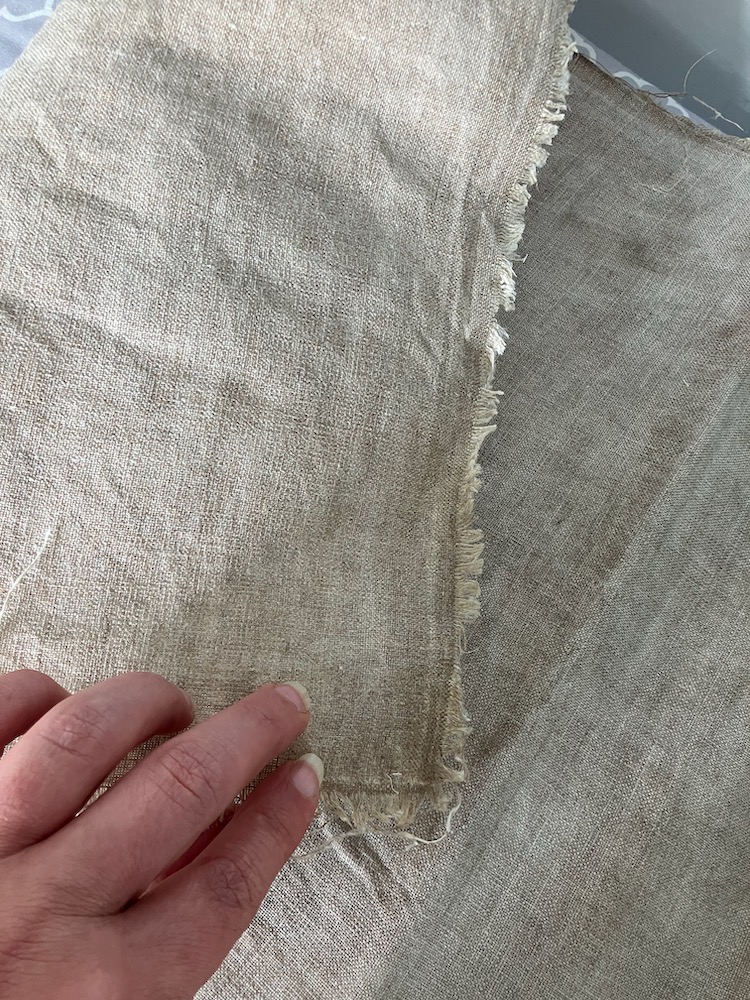
As of the writing of this post I’m not aware of anyone selling pre-made linen buckram that is suitable for staymaking. It’s much better to make your own in any case: cheaper, and you can choose a fabric that’s smooth enough to be comfortable if you don’t line your stays, and use of scraps of leftover fabric for your buckram.
I’ll cover bindings and other notions as we get to them in the making: these three layers, plus your bones, are enough to get started sewing!
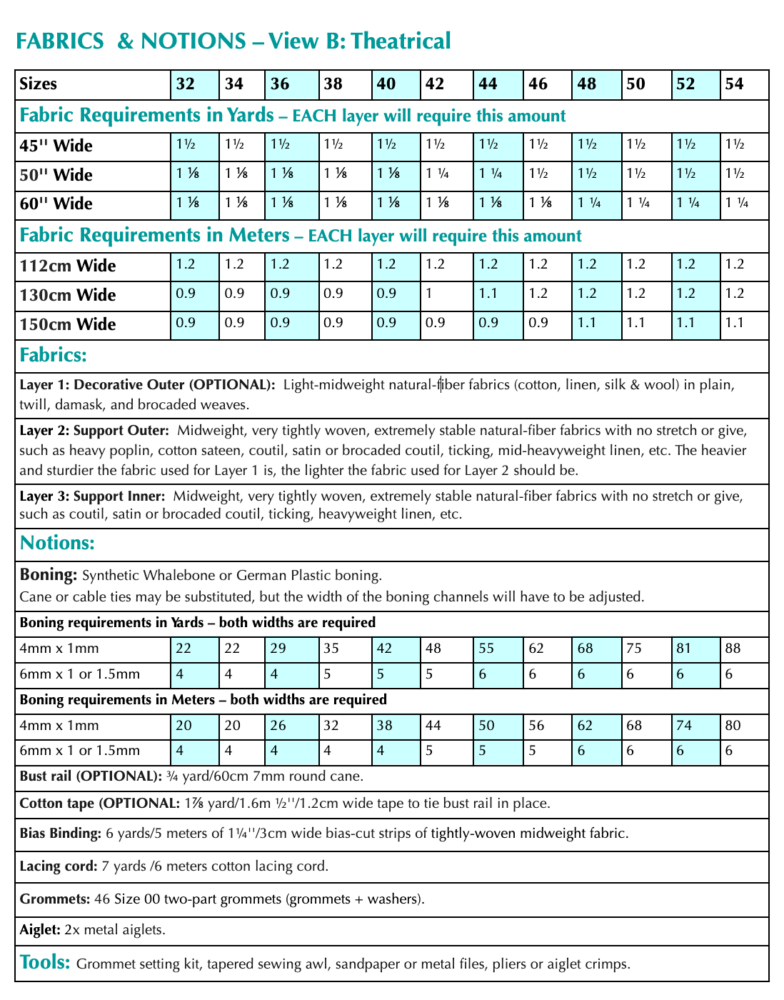
Choosing Materials for View B
Layer 1: Decorative Outer (OPTIONAL)
If you have a fancy fabric you want to cover your stays in, which is not strong enough to protect your body from the bones wearing through, this is where it goes. Just as with View A, this fabric still needs to be robust enough to not wrinkle and pull across the seams. If you really, really love the look of a lightweight fabric, it is possible to make it substantial enough for staymaking by fusing it to a lightweight woven cotton fusible interfacing.
For the View B sample I made for Jenni we only used Layers 2 & 3, because the striped black and white ticking was heavy enough to not need any extra support:
These Augusta Stays, on the other hand, have three layers; the decorative exterior chintz, and two layers of coutil:
Layer 2: Support Outer
Layer 2’s job is to provide structure and support to the stays, and to be robust enough that the bones don’t wear through. The thicker and stronger Layer 1 is, the lighter Layer 2 can be. Whatever fabric you choose, it should be natural fibre, very tightly woven, and very stable, so it doesn’t twist and warp when sewn.
Layer 3: Support Inner
Layer 3’s job is to provide more structure and support to the stays, and to keep the bones from wearing through on the inside and poking your body. Layer 3 could be the same fabric as Layer 2, or could be slightly heavier and more robust.
Here are the black and white stays, in ticking for Layer 2 and white coutil for Layer 3.
My Materials
For my stays I’m making View B, but using the historical making methods. I’ll need the fabrics indicated in View A.
Layer 1: Outer: Yellow & white roses patterned linen damask.
Layer 2: Interlining 1: Mid-heavyweight cream linen.
Layer 3: Interlining 2: Linen buckram made with gum arabica. All the information and a tutorial on this coming tomorrow!
I also have both types of boning (4mm and 6mm), and a length of cane for my bust rail.
Here we go!
Share what you’re making your Cassandra Stays out of!

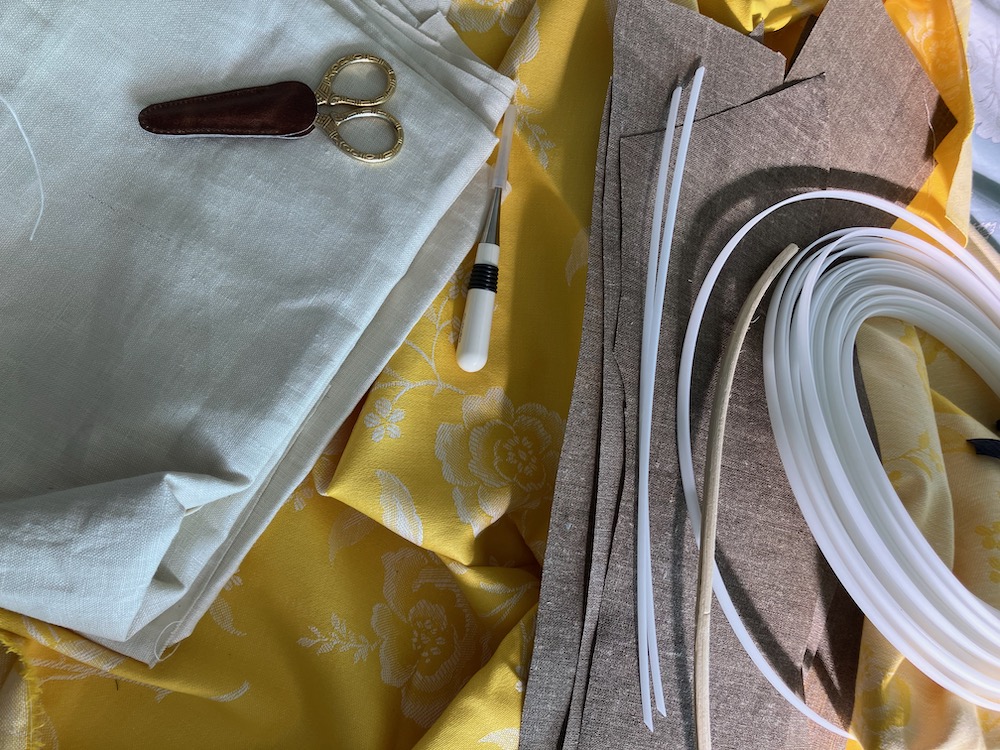



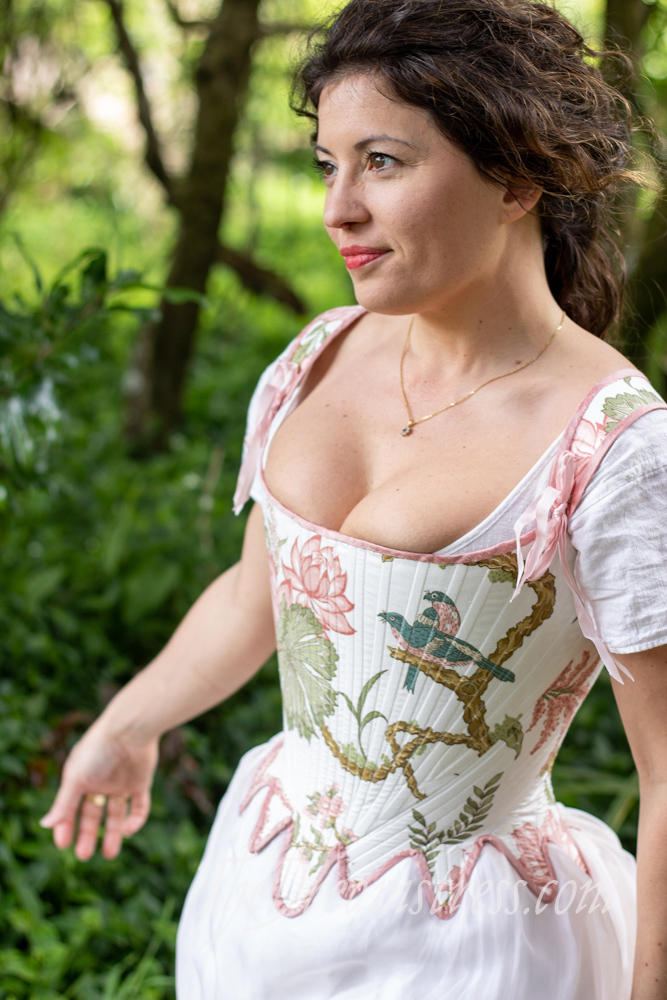
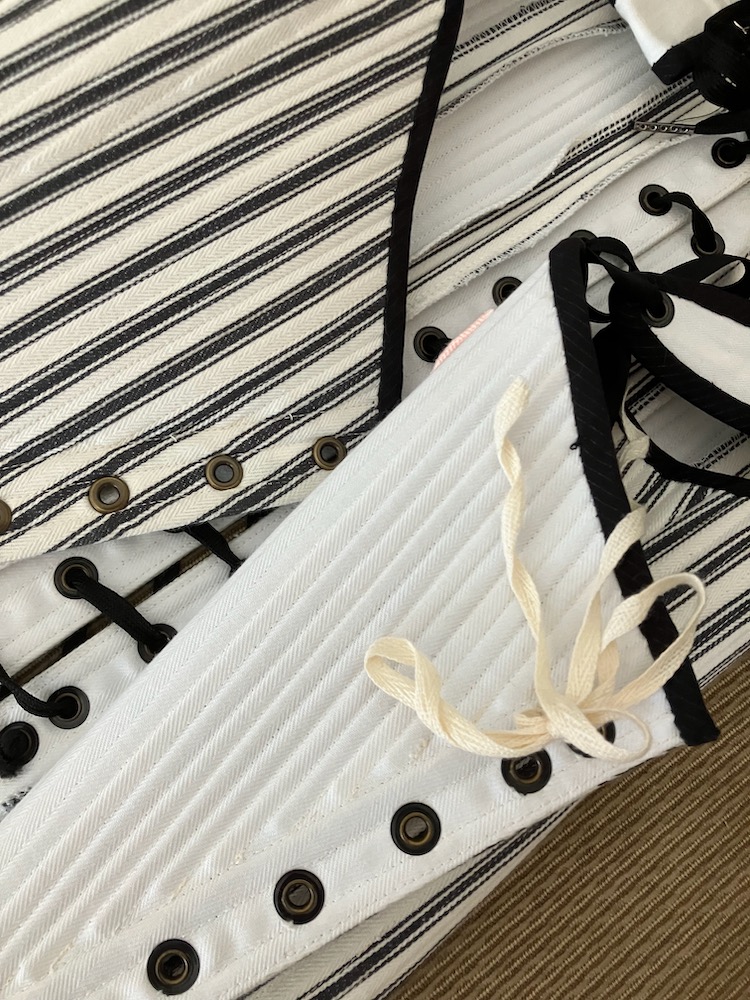
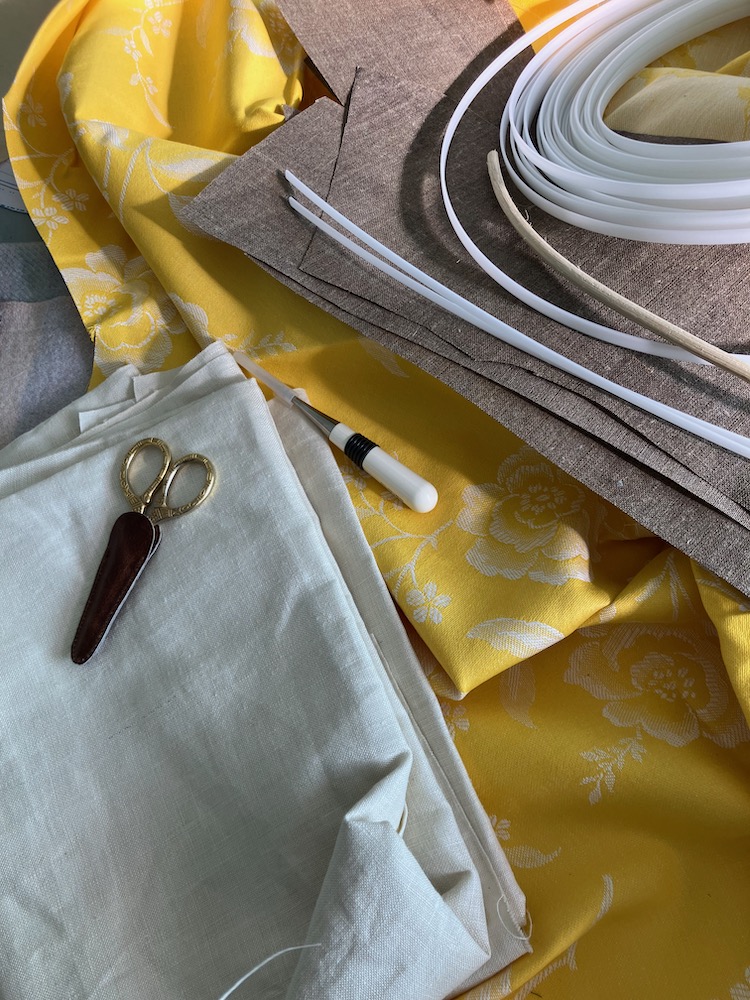
I’ve gone with two layers of very tightly-woven cotton for the support, and a mid-weight green linen for the outer layer. Making view A with machined channels 🙂
I may be able to assist with the then-meanings of “toile” and “toile jaune”. Back in the teens I set out to translate portions of Diderot having to do with clothes. I used dictionaries of the period and later, and books about manufacturing to make sense of the content.
So:
toile:
linen or hemp fabric, sometimes of cotton.
“Tissue of linen or hemp thread. There are also cloths of cotton.” [“tissu du fil de lin ou de chanvre. Il y a aussi des toiles de coton.”] From Jean-Francois Feraud, Dictionnaire critique de la langue francaise, 1887-88.
Sometimes just “cloth”. “It is all cloth in general.” [“C’est toute toile en general…”]. From Jean Nicot, Le Thresor…1606.
Toile: cloth, linen cloth. Toile de coton: callico. {The Royal dict]
Toile jaune:
“A Cholen il se fait des Toiles de lin écrues, les unes bifes & unis, & les autres rayés de differéntes couleurs. Il y en a de fines, de moyennes & de groffes, qui font toutes de ⅔ de large, chape piéce contenant ordinairement 20 aunes mefure de Paris. On fe fert de ces fortes de Toiles pour faire des veftes & des doublures d’été pour habits d’hommes, & de robes de chambre pour femmes. [p. 1153, Dictionnaire uniuersel de commerce: d’histoire naturelle, & des …, Volume 3. https://books.google.com/books?id=1puB5u3fLZEC&pg=PP596&dq=toile+de+lyon&hl=en&sa=X&ved=0ahUKEwjIpbX–KTRAhWU14MKHefACBkQ6AEIHDAA#v=onepage&q=toile%20lyon&f=false%5D
“In Cholen, unbleached linen fabrics are made, some kissed (?) and plain, and others striped in different colors. There are fine, medium and large/heavy ones, all of which are ⅔ wide, a piece usually containing 20 ells of Paris measurement. We use these kinds of fabrics to make jackets & summer linings for men’s clothes, & dressing gowns for women. (Tweaked Google translation).
Back in 2017 I manually translated what I wanted to read. The toule jaune bit, though, hadn’t been touched, and I was amazed at how well Google did today.
Very best,
Natalie in KY USA
Thank you Natalie!
Ooooh, this is exciting! I’m not stay-making (someone should redo that old “wassailing” song as a sort of theme), but I’m so interested to see the whys and wherefores. I like the pretty, cheery daffodil yellow fabric, all over roses, as well.